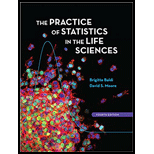
(a)
To find out what percentof people have WAIS scores above
(a)
Answer to Problem 11.25E
Explanation of Solution
In the question, it is given that the scale of scores is set separately for each age group and is approximately Normal with mean
Almost all
Thus, to calculate the percent of people have WAIS scores above
And to calculate the percent of people have WAIS scores above
First calculate the z -value as,
So, it has three standard deviations above the mean so, using
Thus,
And to calculate the percent of people have WAIS scores below
First calculate the z -value as,
So, it has one standard deviation below the mean so, using
Thus,
(b)
To find out what percent of adults would qualify for membership.
(b)
Answer to Problem 11.25E
Explanation of Solution
In the question, it is given that the scale of scores is set separately for each age group and is approximately Normal with mean
Almost all
Thus, to calculate the percent of adults would qualify for membershipfor which scores should be
First calculate the z -value as,
So, it has two standard deviations above the mean so, using
Thus,
(c)
To find out about what percent of adults are mentally retarded according to this criterion.
(c)
Answer to Problem 11.25E
Explanation of Solution
In the question, it is given that the scale of scores is set separately for each age group and is approximately Normal with mean
Almost all
Thus, to calculate the percent of adults are mentally retarded according to this criterion for which scores should be
First calculate the z -value as,
So, it has two standard deviations below the mean so, using
Thus,
Want to see more full solutions like this?
Chapter 11 Solutions
Practice of Statistics in the Life Sciences
 MATLAB: An Introduction with ApplicationsStatisticsISBN:9781119256830Author:Amos GilatPublisher:John Wiley & Sons Inc
MATLAB: An Introduction with ApplicationsStatisticsISBN:9781119256830Author:Amos GilatPublisher:John Wiley & Sons Inc Probability and Statistics for Engineering and th...StatisticsISBN:9781305251809Author:Jay L. DevorePublisher:Cengage Learning
Probability and Statistics for Engineering and th...StatisticsISBN:9781305251809Author:Jay L. DevorePublisher:Cengage Learning Statistics for The Behavioral Sciences (MindTap C...StatisticsISBN:9781305504912Author:Frederick J Gravetter, Larry B. WallnauPublisher:Cengage Learning
Statistics for The Behavioral Sciences (MindTap C...StatisticsISBN:9781305504912Author:Frederick J Gravetter, Larry B. WallnauPublisher:Cengage Learning Elementary Statistics: Picturing the World (7th E...StatisticsISBN:9780134683416Author:Ron Larson, Betsy FarberPublisher:PEARSON
Elementary Statistics: Picturing the World (7th E...StatisticsISBN:9780134683416Author:Ron Larson, Betsy FarberPublisher:PEARSON The Basic Practice of StatisticsStatisticsISBN:9781319042578Author:David S. Moore, William I. Notz, Michael A. FlignerPublisher:W. H. Freeman
The Basic Practice of StatisticsStatisticsISBN:9781319042578Author:David S. Moore, William I. Notz, Michael A. FlignerPublisher:W. H. Freeman Introduction to the Practice of StatisticsStatisticsISBN:9781319013387Author:David S. Moore, George P. McCabe, Bruce A. CraigPublisher:W. H. Freeman
Introduction to the Practice of StatisticsStatisticsISBN:9781319013387Author:David S. Moore, George P. McCabe, Bruce A. CraigPublisher:W. H. Freeman





